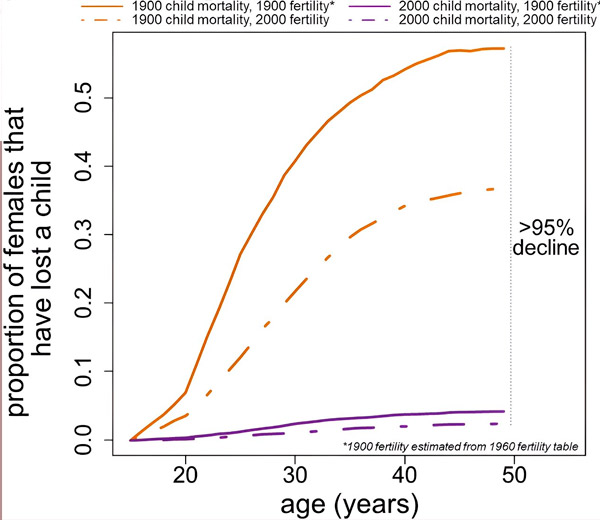Nye publikasjoner
Redusert barnedødelighet forlenger mødrenes liv
Sist anmeldt: 02.07.2025

Alt iLive-innhold blir gjennomgått med medisin eller faktisk kontrollert for å sikre så mye faktuell nøyaktighet som mulig.
Vi har strenge retningslinjer for innkjøp og kun kobling til anerkjente medieområder, akademiske forskningsinstitusjoner og, når det er mulig, medisinsk peer-evaluerte studier. Merk at tallene i parenteser ([1], [2], etc.) er klikkbare koblinger til disse studiene.
Hvis du føler at noe av innholdet vårt er unøyaktig, utdatert eller ellers tvilsomt, velg det og trykk Ctrl + Enter.

En betydelig nedgang i spedbarnsdødeligheten i det 20. århundre forlenget kvinners forventede levealder med et helt år, ifølge en ny studie.
«Jeg forestilte meg hvordan den amerikanske mødrebefolkningen så ut i 1900», sa Matthew Zipple, doktorgradsstudent ved Klarman-programmet i nevrovitenskap og atferd ved College of Arts and Sciences og forfatter av artikkelen «Reducing Infant Mortality Extends Maternal Life», publisert i tidsskriftet Scientific Reports.
«Denne befolkningen besto av to omtrent like store grupper: én gruppe mødre som hadde mistet barna sine og én gruppe mødre som ikke hadde det», sa Zipple. «Sammenlignet med i dag, da tap av barn har blitt mye mindre vanlig, har nesten alle disse kvinnene som hadde mistet barna sine nå flyttet inn i kategorien ikke-sørgende.»
Flere studier viser at mødre har større sannsynlighet for å dø i årene etter et barns død, sa Zipple. Effekten gjelder ikke for fedre.
Ved hjelp av matematisk modellering basert på data fra Centers for Disease Control and Prevention (CDC) beregnet han hvordan fravær av sorg påvirker forventet levealder for moderne mødre i USA. Han anslo at redusert morssorg øker en kvinnes forventede levealder med gjennomsnittlig ett år.
Som doktorgradsstudent som studerte sammenhengen mellom mors helsetilstand og avkom, oppdaget Zipple et mønster av morsdød etter avkomsdød hos ikke-primater. Hos dyr ble denne effekten forklart med at mødrene hadde dårlig helse og var mindre i stand til å ta vare på avkommet sitt.
Men hos mennesker har den samme hendelsesforløpet – avkomdød etterfulgt av morsdød – blitt tolket annerledes i studier med fokus på mennesker. I stedet konkluderer epidemiologer og folkehelseforskere med at de fysiske og psykologiske kostnadene ved traumet ved å miste et barn gjør mødre mer utsatt for å dø.
I artikkelen siterer Zipple flere studier som årsakssammenhenger mellom barns død og økt risiko for mødredød. Den største er en studie av mødre på Island over en 200-årsperiode, som spenner over ulike nivåer av tilgang til helsetjenester og industrialisering. Den kontrollerer for genetikk ved å sammenligne søsken og viser at sørgende fedre ikke har større sannsynlighet for å dø enn ikke-sørgende fedre i årene etter barnets død.
En annen studie i Sverige viser at mødre har høyere risiko for å dø på og rundt årsdagen for barnets død enn på andre tidspunkter. Ifølge ulike studier er hjerteinfarkt og selvmord blant vanlige dødsårsaker blant sørgende mødre.
«Det er en enorm topp i dødelighetsrisikoen rett rundt uken rundt årsdagen», sa Zipple. «Det er vanskelig å komme til noen annen konklusjon enn at det er forårsaket av minnet om hendelsen.»

Forventet levealder for kvinner etter 15 år økte med omtrent 16 år mellom 1900 og 2000, fant Zipple ut fra CDC-dataene som ble brukt i studien. Beregningen hans tilskriver ett år, eller omtrent 6 prosent, av denne økningen til den betydelige nedgangen i spedbarnsdødelighet i løpet av det 20. århundre.
«Noe av det mest forferdelige du kan forestille deg er å miste et barn. Og vi har klart å redusere forekomsten av det i samfunnet vårt med over 95 %. Det er utrolig. Det er noe å feire», sa Zipple.
«Det er lett å overse fremgangen som skjer i løpet av et århundre, fordi den strekker seg utover levetiden til et enkelt individ. Men denne økningen i forventet levealder de siste 100 årene har forbedret levekårene og opplevelsene til folk som aldri før.»
Prioriteringer for fremtiden
Forskningen bidrar også til å sette prioriteringer for å forbedre fremtiden, sa Zipple. Mange land har i dag barnedødelighet som ligner på de i USA i 1900. Å investere i å redusere barnedødelighet overalt hjelper ikke bare barn, men hele lokalsamfunn.
«Barnet er kjernen i samfunnet», sa Zipple. «Å beskytte barn mot dødelighet har kaskader av positive virkninger som starter med mødrene, men som sannsynligvis ikke slutter der.»
